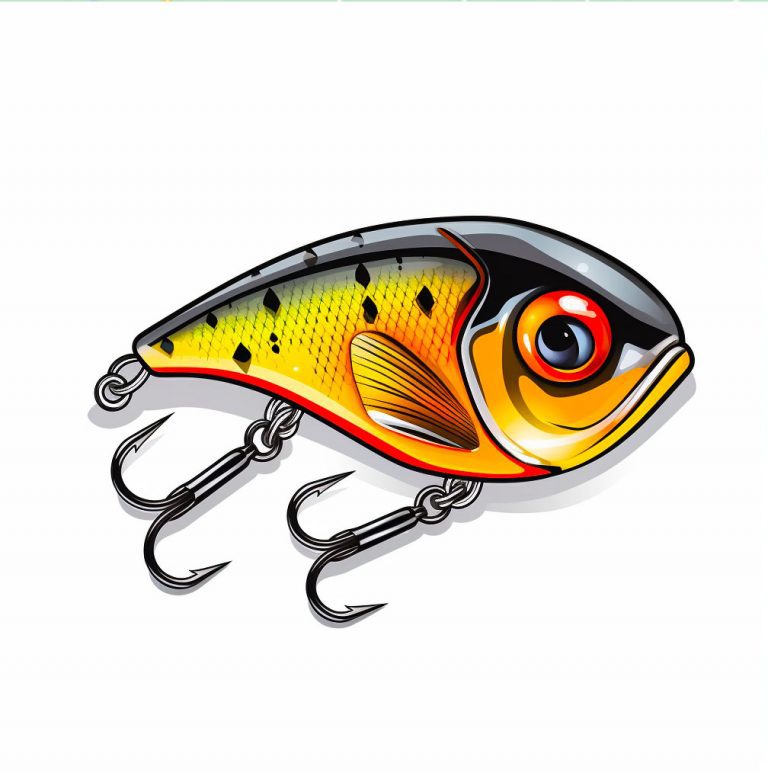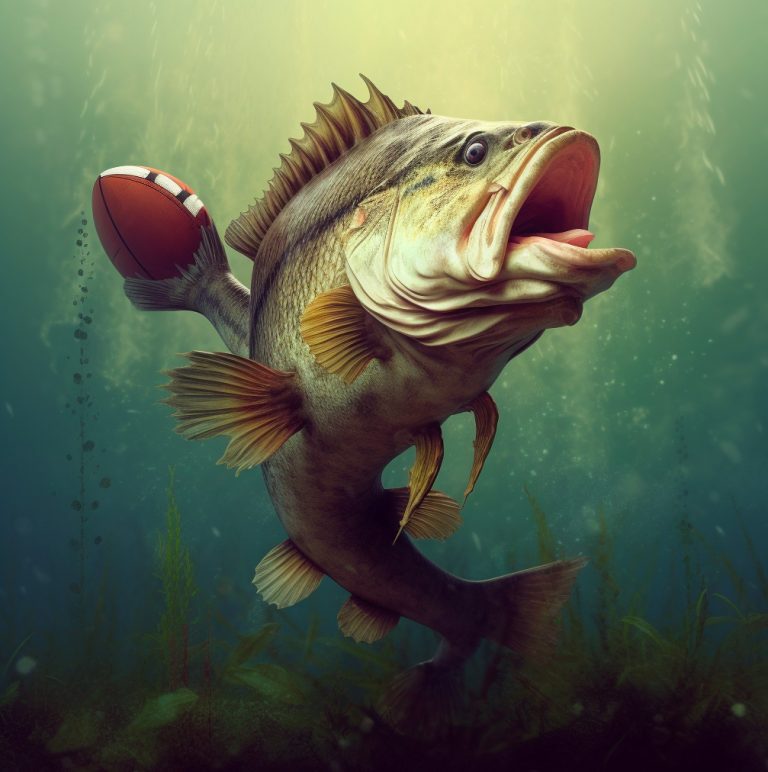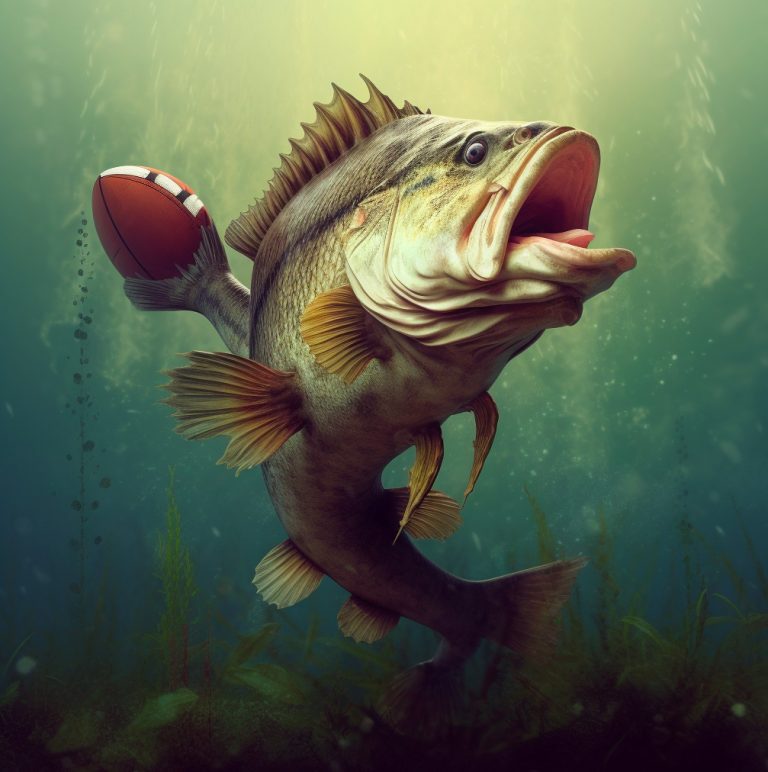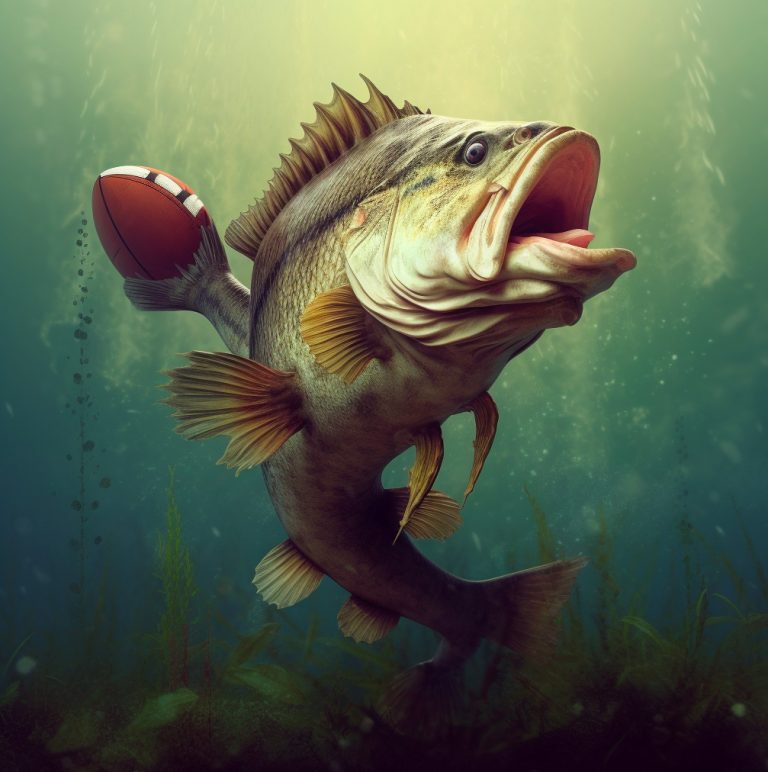“Why did the bass fisherman have trouble with a Texas rigged lure? Because he couldn’t handle the weight of the lone star state on his line!”
Introduction
This post will discuss bass fishing with a Texas rig.
A common fishing method for catching bass is the Texas rig. Usually, a sliding bullet-shaped weight is threaded onto the line, then a worm hook is attached, and then a soft plastic bait like a worm or lizard is used as the bait. The hook tip is then threaded back into the soft plastic bait until it is flush with the body, at which point it is rigged weedlessly.
This setup may be used in a multitude of ways and is highly adaptable. The bait can be dragged on the ground, hopped, swam, pitched, or even flipped into dense vegetation like weeds, trees, or brush. With less snagging and less hanging up, this rig makes it simple to fish both in shallow and deep water.
The Texas rig works well because it allows for a more natural presentation and better hooksets by placing the weight close to the hook. By pulling up on the rod after a bass bites, the angler can quickly set the hook by forcing the hook tip into the mouth of the fish.
Overall, the Texas rig is a well-liked and successful method for catching bass in a range of fishing circumstances.
What Is A Texas Rig?
A. Definition of the Texas rig
A Texas rig is a popular rigging technique used for fishing soft plastics and other artificial lures for bass. The rig consists of a bullet-shaped or egg-shaped weight, a hook, and a bait.
B. Components of the Texas rig
- Hook
The hook is an essential component of the Texas rig. It is designed to pierce through the plastic bait and hook the fish when it bites. Different hook sizes and shapes are available to match different types of bait, and the hook size will depend on the size of the bait used. - Weight
The weight is the critical component that allows the bait to sink to the bottom of the water. The weight also serves to pin the bait in place and prevent it from moving with the current. When selecting a weight, consider the depth of the water, the strength of the current, and the weight of the bait. - Bait
The bait is the part of the rig that ultimately entices the fish to bite. Soft plastic baits, like worms, creature baits, tubes, craws, and lizards, are popular choices since they mimic the appearance and movements of real prey. However, other artificial lures can be used, including jerkbaits, crankbaits, spinnerbaits, and topwater lures.
C. Pros and cons of pegging your weight
Pros:
- Increases sensitivity: Pegging the weight will transmit more vibrations to the rod, allowing you to feel bites and bottom structure more accurately.
- Prevents the weight from sliding: Since the weight is secured in place, it won’t slide up the line towards the bait, reducing the chances of snagging or getting tangled.
- Better casting: With the weight pegged, the rig will be more aerodynamic, improving casting distance and accuracy.
- Reduces line twist: A pegged weight will keep the bait in a straight line with the hook and the line, minimizing line twist.
Cons:
- Limited versatility: Pegging your weight limits the depth to which the bait can sink, making it ineffective in deeper waters or when fishing for bottom-dwelling species.
- Limits bait action: A pegged weight will restrict the movement of the bait, reducing its natural action and potentially decreasing its effectiveness.
- Requires adjustment: Depending on the conditions, you may have to adjust the pegging position to achieve optimal performance, making it a less convenient option.
- Can spook fish: In some cases, the weight bumping against the bait can alert fish and cause them to shy away from the rig.
When To Use A Texas Rig
A. Quick look at suitable conditions for a Texas rig
The Texas rig can be used in a variety of water conditions, but it is particularly effective in areas where fish are found in shallow water, edges of vegetation, or flooded timber. Texas rigging also works well in heavy cover and structure, particularly in areas where it would be difficult to use other fishing techniques.
- Water Temperature: Water temperature plays a significant role in the activity level of bass. In colder water, bass tend to become lethargic and slow, and they don’t bite as much. As the water temperature warms up, bass become more active and aggressive. In general The water temperature should be between 50-80 degrees Fahrenheit.
- Water Clarity: In clear water, bass can see the bait from a distance, which makes it essential to use a more natural-looking bait. In murky water, bass rely more on their sense of vibration and sound to locate prey, which tends to favor baits that produce strong vibrations.
- Weed or Grass Lines: Bass love to hang out near weed or grass lines because it provides them with cover and an opportunity to ambush prey. Fishing a Texas rig along these lines can be very effective, as the worm can be worked slowly along the structure or through the open areas around the weeds.
- Underwater Structure: Look for underwater structures like rocks, logs, and drop-offs, where bass would usually hang out. These structures act as natural cover for bass and help them ambush prey. Fishing a Texas rig along these structures can trigger some aggressive strikes.
- Current: In areas with current, bass will usually face upstream waiting for prey to come to them. Fishing a Texas rig up-current and letting it drift naturally with the current can be very effective. The current also helps to move the bait in a more natural manner, which can create a realistic presentation for the bass.
In summary, each of these water conditions plays a crucial role in fishing a Texas rig for bass effectively. Understanding these conditions can help you select the right bait, choose the right area to fish, and present your bait in a way that triggers strikes.
B. Target Largemouth, Smallmouth and Spotted Bass
A variety of bass species, including largemouth, smallmouth, and spotted bass, can be caught using the Texas rig as a bait.
As ambush predators, largemouth bass are well known to be caught with the Texas rig. A largemouth can readily find the bait thanks to the setup, which lets the bait fall naturally to the bottom. The rig’s weedless construction also enables the use of the bait in areas of dense cover where large bass are known to hide.
Compared to largemouth bass, smallmouth bass are more active and favor baits that move quickly. The Texas rig can be used with a wide range of soft plastic baits, from creature baits to worms, and can be fished with a faster retrieve to attract smallmouth bass.
Compared to its largemouth and smallmouth relatives, spotted bass, also known as Kentucky bass, frequently inhabits deeper waters. By adding weight to the bait using the Texas rig, fishermen may quickly lower it to deeper depths where spotted bass are probably feeding.
The Texas rig, in general, is a great all-around bait for capturing bass in a number of situations. It is a fantastic option for fishermen pursuing largemouth, smallmouth, and spotted bass due to its adaptability and capacity to resemble natural bait.
C. Advantages of Texas rigs over other fishing techniques
Texas rigs are versatile and can be fished in a variety of water conditions, including heavy cover, shallow water, and structure. The approach is straightforward to use, and anglers who are new to fishing can quickly learn how to rig and fish with a Texas rig.
- Versatile: The Texas rig is versatile, and it can be used in various types of water bodies, including rivers, lakes, ponds, and canals. It works in clear waters and murky waters, rocky bottoms, and thick vegetation.
- Weedless: Bass often stay close to weeds, where they can find shelter and food. The weedless Texas rig allows anglers to fish in these areas without getting tangled in the weeds. It can be the difference between catching a fish and losing a bait.
- Easy to fish: The Texas rig is simple to use and is suitable for anglers of all skill levels. It can be fished with a slow retrieve, allowing the bait to move naturally through the water and attract fish.
- Sensitive: The weight on the line creates tension, allowing anglers to feel every movement of the bait. This sensitivity makes it easier to detect even the slightest bite.
- Customizable: The Texas rig is highly customizable, with the ability to change the bait size, color, and type to target specific species and conditions. It accommodates soft plastics, creature baits, and worms, among others.
- Effective: The Texas rig is effective at catching bass in many conditions, including shallow and deep water, isolated structure, and along drop-offs. It is a popular setup among professional and recreational anglers alike. The Texas rig is capable of catching both largemouth and smallmouth bass and is a consistent producer of bites all over the country.
How To Texas Rig For Bass
A. Step-by-step instructions on how to rig
- Tie A Hook
Start by tying a hook to the end of the line using the preferred knot. Ensure the hook’s size is appropriate to the size of the bait, as this affects how effectively the bait will penetrate the fish’s mouth. - Slide in the Weight
Next, slide the weight (bullet-shaped or egg-shaped) to the end of the line above the hook. The weight’s size again will depend on the depth of the water and the weight of the bait. - Insert the Bait
Insert the bait onto the hook, ensuring it covers the hook entirely. Be careful not to thread the bait too deeply into the hook as this can affect the rig’s action and movement.
B. Tips for choosing the right hook, weight, and bait
Hook
When selecting the hook, consider the size and shape compatible with the chosen bait. Ensure the hook can penetrate the fish’s mouth effectively and the bait is secured in place on the hook.
VMC Wide Gap Worm Hook: This hook is perfect for Texas rigging soft plastic worms and lizards. It has a wide gap to accommodate larger baits and a needle sharp point for easy hook penetration. It comes in various sizes from 1/0 to 5/0.
Gamakatsu Offset EWG Worm Hook: This hook has a unique offset design that allows for better bait presentation and a higher hookup ratio. It has a conical point that is extremely sharp, making it easy to set the hook. It comes in sizes 2/0 to 5/0.
Eagle Claw Worm Hook: This hook is made from high-carbon steel and has a sharp point that stays sharp longer. It is perfect for Texas rigging soft plastic worms and other baits. It comes in sizes 1/0 to 5/0.
Trokar TK130 Magworm Hook: This hook is designed for larger baits and has a wide gap and heavy wire construction for added strength. It has a surgically sharpened point that penetrates quickly and easily. It comes in sizes 3/0 to 7/0.
Weight
Choose the weight based on the depth of the water, the strength of the current, and the weight of the bait. The optimal weight will ensure the bait sinks quickly to the bottom of the water and be secure in place when the fish bite.
Bait
The bait selected must match the water context and the type of fish being targeted. Soft plastic baits are popular choices and can range from worms, tubes, craws, and lizards. Other artificial lures like jerkbaits, crankbaits, spinnerbaits, and topwater lures can also be used.
C. Proper Technique for Casting and Retrieving
To cast the Texas rig, hold the rod with both hands and flick the wrist forward to send the bait out. To retrieve, drag the bait across the bottom to simulate natural prey, ensuring it touches the cover and structure. The Texas rig’s use requires patience and persistence, as fish will often bite slowly and may require many casts to catch.
Advantages Of Texas Rigging
A. Greater sensitivity and control
Texas rigging offers greater sensitivity and control than other fishing techniques like live bait or trolling. The angler can feel the slightest nibble and with subtle movements of the rod, persuade the fish to bite.
B. Ability to fish in cover and structure
The advantage of a Texas rig is that it can be fished in cover and structure that other techniques may not penetrate. The rig can move around rocky outcrops, weeds and burrows where fish may be hiding.
C. Less snags and lost baits
The Texas rig’s design allows for fewer snags and lost baits compared to other fishing techniques that can get caught on sticks, weeds, or other debris.
How To Retrieve A Texas Rig
Slow drag and lift
For this retrieve, cast your rig out and allow it to sink to the bottom. Slowly drag the rig along the bottom with short, slow pulls, making sure to keep in contact with the bottom. Then, lift the bait a few inches off the bottom and let it sit there for a few seconds before repeating the drag. This movement can mimic the action of a crawling worm or crayfish, which can trigger a strike from bass.
Steady retrieve
This is a simple retrieve that involves reeling in your bait at a steady pace without any jerky movements. This works best when fishing in deep or open water, where bass are actively searching for food.
Twitching and pausing
Cast your rigged bait out and allow it to sink to the bottom. Twitch your rod tip to create small movements in the bait, then let it sit for a few seconds before twitching again. This technique can mimic a wounded baitfish, which can attract the attention of feeding bass.
Jigging
Cast your rig out and allow it to sink to the bottom. Jerk your rod tip upward to create a jigging motion, then let the bait fall back to the bottom. Repeat this motion, making sure to reel up any slack line as you do. This technique can mimic the fleeing movement of baitfish, which can trigger a predatory response from bass.
Bottom hopping
Cast your rigged bait out and allow it to sink to the bottom. Then, quickly snap your rod upward to hop the bait off the bottom a few inches. This movement can mimic the movement of a crawfish or shrimp, which can attract the attention of bass lurking near the bottom.
Remember to experiment with different retrieves to find what works best for the particular body of water you’re fishing in and the species of bass you’re targeting.
Best Baits
A. The top lures for Texas rigging
Soft plastics like worms, creature baits, tubes, craws, and lizards, are popular choices, as they mimic the appearance and movements of real prey.
B. Advantages and disadvantages of different baits
Worms and creature baits are versatile, have a natural look, and are easy to rig. Tubes are popular for their unique shape and ability to create more action in the water. Craws and lizards mimic real prey and are designed to attract fish in heavy cover.
C. Tips for selecting the best bait for different situations
When selecting the best bait for different contexts, consider the target fish species, water clarity, and temperature. If the water is slightly murky, a bait with a bright color is recommended, while if the water is clear, a more natural color may be better.
D. Brand Recommendations
- Zoom Bait Company – They offer a variety of soft plastic bait options such as the Zoom Brush Hog and Zoom Trick Worm that you can use on a Texas rig.
- Strike King Lures – Another popular brand known for their rage tail products like the Strike King Rage Craw.
- Gary Yamamoto Custom Baits – They also provide various soft plastic lure options, but the Yamamoto Senko in particular is a go-to for many anglers.
- Berkley Fishing – Known for their PowerBait line, Berkley offers numerous soft plastic bait types to use on a Texas rig.
- Gambler Lures – Specializing in craw-style baits like the Gambler Crawdaddy for the Texas rig.
- YUM Baits – Offering both soft and hard lures, YUM has several rubber worm varieties that are great for Texas rig fishing.
Remember, the best lure for Texas rig fishing can vary based on the type of water and species of fish you’re targeting.
E. Best Colors
- Natural colors: Colors that mimic natural baitfish or crawfish can be effective on Texas rigs. Earthy tones such as green pumpkin or brown are popular choices. Watermelon colors can also be effective as they blend in with the greenery and algae in the water.
- Bold colors: Bright and bold colors such as chartreuse and orange can work well in murky, stained water. These colors can help attract fish and make your bait stand out.
- Dark colors: Black and blue are great colors for fishing in murky water or on cloudy days. These colors can create a silhouette which can attract fish from a distance.
- UV-reactive colors: Baits that are UV reactive can be effective in low light or cloudy conditions. These colors glow under UV light, making them more visible to fish.
Troubleshooting
A. Identify and solve common problems with Texas rigs
- The bait not sinking to the bottom quickly. In this case, consider adding more weight to the rig.
- Lack of sensitivity to the bite. If an angler is having trouble feeling any bites, try using a more sensitive rod.
B. Solutions for fish not biting
If fish are not biting, consider changing the bait’s color, size, or shape. Alternatively, try using a different fishing technique or moving to another location.
C. Handling snags and line tangles
Snags and line tangles are common problems when texas rigging. Unloop the snagged line, and try again. Alternatively, use the rod’s flexibility to shake the bait loose and continue fishing.
D. Mistakes Anglers Make When Fishing Texas Rig
- Wrong Hook Size: Using the wrong hook size is one of the most common mistakes that anglers make while fishing using Texas rigs. Hook size plays an essential role in catching big bass, so it’s essential to choose the right hook size that matches the size of the bait.
- Incorrect Weight: Another mistake anglers make is choosing the incorrect weight for their Texas rigs. The weight should be chosen according to the depth you are fishing in.
- Not Paying Attention to Line Selection: The right line selection is crucial in Texas rigs as it affects the casting distance and the sensitivity of the line. It’s essential to choose a line that can withstand the weight of the bait.
- Not Setting the Hook Properly: Setting the hook is critical when fishing with Texas rigs. Waiting too long to set the hook or setting it too early can result in losing the catch.
- Not Using the Right Bait: Using the wrong bait with Texas rigs can make a huge difference in the number and size of the bass you catch. So, make sure you use the bait that suits the feeding habits of the bass in your area.
- Fishing Too Fast or Too Slow: The speed you fish at is another crucial factor that impacts the catch. Bass prefer a slow-moving bait, so it’s essential to adjust the speed to match the feeding habits of the bass.
In summary, anglers should pay attention to hook size, weight, line selection, setting the hook properly, using the right bait, and fishing at the right speed to maximize their success with Texas rigs.
Best Places to Fish A Texas Rig
Around submerged vegetation or weed beds
Bass love to hide in vegetation and ambush prey. Texas rigs work great in this type of habitat because they allow the bait to be presented to bass in a way that looks natural and allows them to capture the prey without expending too much energy.
Along drop-offs or ledges in the bottom structure
Bass tend to move along bottom structures such as drop-offs and ledges in search of food. Texas rigs can be worked slowly along these structures, giving the bass ample opportunity to spot and strike the bait.
Near woody cover such as fallen trees or brush piles
Woody cover is a favorite hiding spot for bass because it provides them with both cover and easy access to prey. Texas rigs can be worked through and around the cover, giving the angler a great chance to catch a lurking bass.
Along rocky shorelines or points:
Bass can often be found near rocky shores or points, especially if there is a change in depth or current nearby. A Texas-rigged bait can be moved slowly along the rocky structure, allowing the angler to make precise cast and present the bait in a way that maximizes its chances of getting bit.
In and around docks and boat houses
Docks and boat houses can be hotspots for bass, as they offer shade, cover, and plenty of food sources. Texas rigs can be worked slowly around these structures to entice strikes from any nearby bass.
Near creek or river channels
Bass often congregate near creek and river channels, especially in the deeper sections near the edges. Texas rigs can be worked slowly along these channels, giving the fish plenty of time to spot and attack the bait.
In deeper holes or pockets in the water
Bass will often take up residence in deeper holes or pockets in the water, especially if the surrounding water is shallower or faster moving. A Texas-rigged bait can be worked slowly along the edges of these holes or pockets to draw strikes.
Along riprap or other man-made structures such as bridge pillars
Man-made structures such as riprap or bridge pillars can attract and hold bass, as they provide hiding spots and a ready supply of prey. Texas rigs can be worked slowly along these structures, allowing the bait to mimic a real-life prey animal and draw strikes from nearby bass.
Fishing A Texas Rig In Brush Piles
Freshwater bass fishing using Texas rigs in brush piles is a well-liked and productive method. In the water, brush piles are artificial or natural structures that offer fish cover, shelter, and protection. Anglers can lower their bait close to the bottom without it tangling on the brush by using a Texas rig when fishing in brush piles. In this post, we’ll examine the Texas rig in more detail and discuss how to use it to catch fish in brush piles.
Best Weight for brush piles
Depending on the size of the bait and the depth of the water, several weights are employed in a Texas rig. When fishing in brush piles, a 1/8 to 1/2 ounce bullet weight typically works effectively. Anglers should select a hook that matches the size of the bait they’re using because the size of the hook is also crucial.
Locating the brush piles
Keep in mind a few factors while using a Texas rig to fish in brush piles. Finding the brush pile is the first step. Numerous locations, such as next to submerged logs, on rocky outcrops, and close to drop-off edges, are home to brush piles. Once you’ve located the brush pile, take sure to approach it cautiously to avoid scaring off any surrounding fish.
Drop your Texas rig into the water when you get close to the brush pile, letting it sink all the way to the bottom. To be able to feel any bites or bumps on the line, it’s critical to keep your line taut at all times.
Retrieve
Drag your rig slowly over the top of the brush pile once it is on the bottom. This will enable you to cast your bait close to the fish that are seeking refuge in the undergrowth. Remember that you might need to change how much you’re carrying to avoid tripping over the undergrowth.
Pay particular attention to how your bait feels on the line as you drag your Texas rig through the vegetation. Set the hook by drawing the rod tip up if you feel a bite or bump. As a result, the fish should swallow the hook and you should be able to reel it in. When using a Texas rig, keep in mind that you frequently don’t need to set the hook all that hard because the rig’s weight will usually take care of that for you.
Get The Fish Out
Be careful not to let your catch become entangled in the brush pile as you reel it in. If this occurs, slowly push the fish out of the brush by gently moving your rod tip back and forth. You might need to maneuver your boat closer to the brush pile to gain a better angle if the fish is still stuck.
Catch Bigger Fish in Brush Piles
One advantage of using a Texas rig when fishing in brush piles is that you can go after bigger fish. Fish that linger out in open water are typically smaller and less cautious than fish that use brush piles as cover. This implies that in order to effectively land a large fish, you will need to utilize a larger rod and line.
Best Rod For Brush Piles
A medium to heavy power rod with a fast action is ideal for Texas rig fishing in brush piles. This will provide you the ability to rapidly set the hook and have the strength necessary to remove the fish from the brush pile. Most conditions can be handled by a rod between 6’6″ and 7′.
Right Line
It’s crucial to pick the proper line when fishing in brush piles. Fluorocarbon line is a wise choice because it has good sensitivity and is less noticeable in the water. For the majority of fishing circumstances, a 12 to 15 pound test line is suitable. When fishing in brush piles, you might want to upgrade to 17 or 20 lb line, though!
Other Brush Pile Baits
There are various rigs you can use when fishing in brush piles in addition to the Texas rig. The Carolina rig, which combines a hook, a weight, and a leader with a soft plastic bait, is one well-liked choice. The Carolina rig enables the presentation of the bait close to the bottom without risking it tangling in the vegetation. Anglers can also feel any bites or bumps on the line thanks to the weight of the setup.
Finally, a wonderful method for catching bass in freshwater is by fishing Texas rigs in brush piles. Anglers may master the art of fishing effectively in and among brush piles with a little time and care. Just keep in mind to respect the environment and the fish that live there, and to always abide by local fishing laws.
Fishing Texas Rigs For Bass By Season
Winter
Fish will often migrate to the deepest areas of the water during the winter because there, the water is warmer. To lower your bait to these deeper levels, you should employ bigger weights. With your Texas rig, try employing bullet weights between 1/2 and 3/4 oz. Additionally, you should fish more slowly to give the fish time to respond to your bait. Concentrate on fishing at points, drop-offs, and humps because these are where fish naturally gather. During the winter, jigs and soft plastic lures like worms and craws are effective.
Learn about the best winter baits.
Prespawn
Fish begin to transition from their winter routines towards shallower water in the weeks before spawning season. Continue fishing in deeper water, but also pay attention to shallower features like flats, ditches, and breeding grounds. Use a variety of soft plastics, including jigs and worms and craws. You can start to fish more quickly and employ more forceful retrieve techniques as the water heats.
Learn about the other best baits for the prespawn
Spawn
Fish go towards very shallow water to spawn during the spawning season. Fish that are defending their nests are what you should target when bed fishing. To tempt fish that are feeling protective, use a Texas rig with a worm or craw. Try to locate regions where fish are actively constructing beds because these are frequently good areas to target. When catching and releasing fish that are in the process of spawning, keep this in mind.
Learn about the best baits for the spawn
Post spawn
Fish start to go back into deeper water after spawning season. You should start targeting offshore features like brush piles and ledges for fishing. During this time, a Texas rig with a worm, craw, or creature bait can be effective. You can retrieve the bait in a number of ways, such as by dragging it across the bottom, hopping it, or bouncing it off of objects. If you want to keep your bait a little bit off the bottom, you should fish more slowly and with lesser weights.
Learn about the best baits for the post spawn
Summer
Fish typically migrate to deeper water during the summer to escape the heat. With a range of soft plastics including worms, craws, and creature baits, you should concentrate on targeting offshore features and points. Fish tend to be more active at this time of year, so you can use bigger weights to get your bait down more quickly. During the summer, faster retrieval methods like hopping and popping will be effective.
Learn about the best baits for the summer
Fall
Fish begin to move back to shallower water in the fall as they get ready for the winter. You should concentrate on using a range of soft plastics, like as worms, crawfish, and creature baits, to fish shallow structures. Fish will start to get more active as the water cools, so you can start fishing more ferociously. To attract fish, you can utilize topwater lures and faster retrieve tactics like hopping and popping. To locate active fish, keep in mind to vary your retrieve speed and cover water.
Learn about the best baits for the fall
Advanced Tips For Texas Rigs
- Experiment with different hook sizes: Matching the hook size to the size of the bait and the size of the fish you are targeting is crucial. When using a larger bait or targeting larger fish, use a larger hook size for a solid hookset. For smaller baits or finesse fishing, smaller hooks are better.
- Vary the weight of the sinker: The weight of the sinker will affect how quickly the bait sinks to the bottom. The right weight is crucial to keep your bait in the strike zone and avoid snagging on underwater obstacles. Experiment with different weights and choose the heaviest weight that allows the bait to fall naturally and with minimal resistance.
- Keep slack out of the line: Keeping slack out of the line ensures that you can detect even the slightest bite from a fish. This requires a sensitive rod paired with a high-quality reel that has a smooth drag system.
- Use braided line: Braided line is thinner and more sensitive than monofilament or fluorocarbon line. This sensitivity allows you to feel everything that’s happening underwater and sets the hook quickly.
- Use scent attractants: Adding scent attractants to your bait can attract more fish and make them hold onto the bait longer. Garlic, crawfish scent, and other scents are effective in luring in more fish.
- Change colors according to water conditions: Water clarity affects the color of the bait. Use natural colors like brown or green in clear water and brighter colors like chartreuse or white in murky water so that the bait stands out.
- Practice casting accuracy: Practice casting accuracy helps you get your bait right where you want it, minimizing frustration and increasing your chances of success. It’s always crucial to practice casting, and experiment with different techniques.
Explore Even More and Some Of These More In Depth in The Video Below
Conclusion
Texas rigging can be a highly effective fishing technique when used correctly. This article has provided an introduction to Texas rigging, including the definition of the rig, the components, when to use the rig, how to Texas rig for bass, advantages of the technique, best baits and troubleshooting tips. By trying this technique, anglers will be able to catch bass in areas they have always previously ignored and increase their chances of catching those elusive fish. Success with Texas rigging often

Megabass Dark Sleeper Swimbaits For Bass
Introduction As an avid bass fisherman, I’m constantly on the lookout for new gear and tools to improve my chances of catching bigger and better bass. Recently, I came across the Megabass Dark Sleeper Swimbaits, and my curiosity was piqued. What makes these swimbaits so special? Do they really live up to their reputation among […]

Swim Jigs For Bass: A Comprehensive Guide
Introduction As a bass angler, I’ve always been intrigued by swim jigs. They’re one of the most talked-about and effective lures in the sport, but there’s something about them that always left me perplexed. What is it about swim jigs that make them so effective? How do you choose the right one for each situation? […]

Guide To Catching Bass With Rapala DT Crankbaits
Introduction Bass fishing is one of my absolute favorite hobbies. There’s something about the thrill of the chase, the excitement of reeling in a big catch, that just can’t be matched. Over time, I’ve tried out a variety of different lures and techniques to reel in those big bass, but I have to say that […]

A Guide To Catching Bass On Football Jigs In Every Season
Introduction: Football jigs are a versatile and effective fishing lure that can be used to catch bass all year round. However, different seasons require different approaches when it comes to fishing, and the same is true for football jigs. As an avid angler, I have spent countless hours fishing for bass using football jigs, and […]

Best Rod, Reel and Line For Football Jigs
Introduction As I sit here on the shores of my favorite fishing spot, I can’t help but feel perplexed by the amount of gear that fishermen bring with them. Every angler seems to have their own unique setup, from rods to reels to lines. And while I appreciate the variety, it also begs the question […]

A Guide To Football Jigs For Bass
Introduction As a lifelong angler, I’ve tried my hand at countless types of fishing for different species. But when it comes to fishing for bass, there’s one technique that has stood out above the rest: using football jigs. At first, I was skeptical. The jigs didn’t look like they had much action in the water […]

